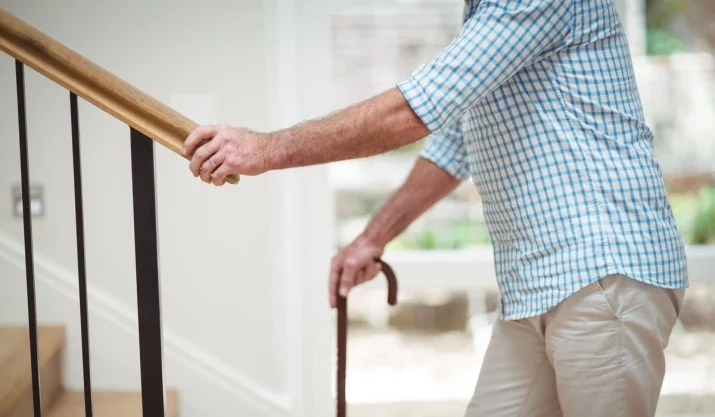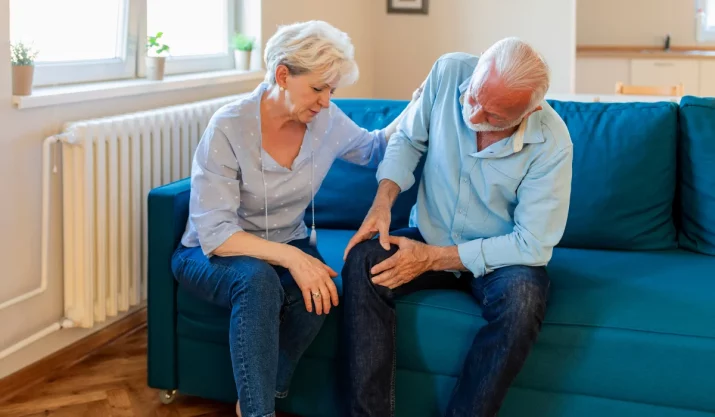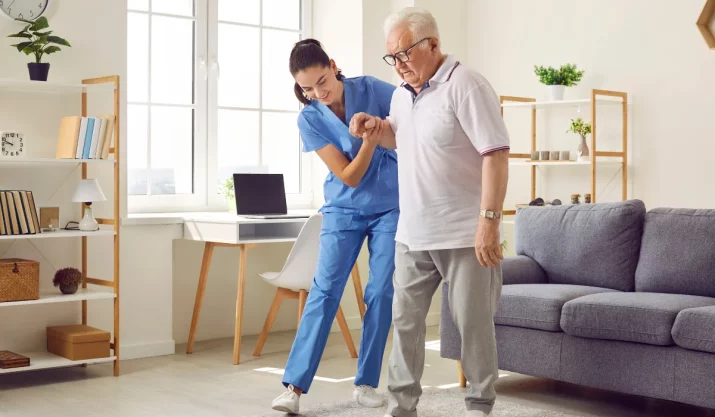Empowering Your Elderly Loved One: Tips for Navigating Stairs

Table of Contents
If you have an elderly loved one, you’ll know just how concerning it can be to watch them grow unsteady on the stairs (even more so if they’re disabled). 51% of all fall-related traumatic brain injuries (TBIs) occur on stairs for older adults. But there are safer ways to help your loved one go up and down the stairs, even if they use a cane, walker, or wheelchair.
Read on to learn best practices for helping your loved one on the stairs, and to learn about safety features you can have installed on their home staircase.
Key Takeaways
- There are proper techniques when it comes to helping an elderly person ascend and descend the stairs, whether they use a cane, a walker, or a wheelchair.
- Using a cane is the safest and easiest option if your loved one is able to stand and walk with one.
- Safety tools like a safety gait belt, non-slip stair treads, handrails, or a stair lift may grant you additional peace of mind as part of your loved one’s home care plan.
How to Help an Elderly Loved One Up the Stairs
Whether your senior loved one’s primary walking aid is a cane, a walker, or a wheelchair, there are certain techniques you should use to provide extra support to help them safely climb stairs. Below are the best practices for caregivers and loved ones when it comes to each situation.
With a Cane
If your senior loved one or elderly parent is able to stand and walk and use a cane or walking stick, helping them get up stairs using said cane is likely your safest and easiest option, as canes are the least cumbersome and can help your loved one balance.
- Have your loved one grab the handrail of the staircase with one hand (gripping it tightly) and hold their cane in the other hand.
- Position yourself on the side on which your loved one is holding the cane (this is typically their weaker side).
- Have them step with their stronger leg (side towards the handrail) first while keeping the cane in place on the step below, then their weaker leg, and finally the cane, spotting them throughout the process.
You may also choose to keep one of your hands on the railing behind them and one supporting the cane.
With a Walker
If your loved one is able to stand and walk using a cane, that is likely a safer and easier option for climbing the stairs. However, if they can only use a walker (or that’s all you have on hand), there’s a safe technique you can use.
- Support your loved one from behind by grabbing onto their pants or waistband (or a safety gait belt).
- Have them hold the handrail with one hand, and turn the walker sideways on the other side, remembering to lock the brakes if applicable.
- From there, your loved one can use the front two legs of the walker to support themselves while keeping the back two legs on the stair below them until they ascend.
- They (or you) can lift the walker to meet them. On landings or spaces between flights of stairs, the walker can be turned back and used as normal.
With a Wheelchair
If at all possible, it’s recommended that you recruit a partner to help you get a wheelchair-using person up the stairs. However, getting your wheelchair-using loved one up the stairs is possible alone in a pinch.
- Start by bringing any extra items (such as a backpack or blanket) up the stairs to eliminate weight and obstacles. You can even remove additional tippers or unnecessary parts of the wheelchair.
- Lock the brakes of the wheelchair and put on your loved one’s seat belt.
- Turn the wheelchair backwards (so the back faces the steps). Position one person in front of the wheelchair and one person behind, and be sure to lift the chair properly (wide stance, slight squat or kneel to avoid back injury).
- Communicate with your partner as you lift the chair up each stair, pushing on the handles to tilt the chair back with each step up.
If your loved one is not able to understand what’s going on, one or both of you may need to calm or restrain them.
If you’re alone and able to lift the wheelchair yourself, do so backwards and from behind, slowly and carefully. You may also choose to unlock the brakes, pulling your loved one up each step using the wheels.
How to Help an Elderly Loved One Down the Stairs
Helping your loved one get down stairs can be equally (if not more) daunting. Below are the safest methods for helping your friend or family member descend the stairs with a cane, walker, or wheelchair.
With a Cane
Using a cane to help your elderly relative down the stairs is the safest and easiest option, so you should suggest your loved one use a cane wherever possible. The process for descending stairs with a cane is nearly identical to the process for ascending (but in reverse).
- Have your loved one grab the handrail and place their cane firmly on the first step down. Stand in front of them, towards the side the cane is on.
- Have them step down first with their weaker leg (the one on the side of the cane), followed by their stronger leg, spotting them as they go.
Continue this process slowly and carefully, having your loved one step with the cane first, for each step until you reach the bottom of the stairs.
With a Walker
The process for descending the stairs with a walker is also nearly identical to the ascent process (but in reverse).
- Stand on the stairs in front of your loved one and grab onto their belt or waistband (or a safety gait belt).
- Have them turn their walker sideways and place the front two legs down onto the step in front of them (remembering to lock the brakes if needed).
- From there, you can secure the front of the walker with your other hand while your loved one uses the back like a cane.
- Have your loved one descend the steps to meet the front of the walker, then bring the back of the walker to meet them, and so on.
With a Wheelchair
Helping someone down the stairs in a wheelchair is also an identical, but reversed, process to helping them up. Recruit a partner to help you if at all possible.
- Bring any extra items (i.e. backpack, blanket, extra tippers) down first, lock the brakes of the wheelchair, and strap your loved one in.
- Lift the wheelchair with your partner (one of you in front and one of you behind), being sure to assume the proper stance (feet wide, slight squat or kneel).
- Communicate with your partner as you descend each step, tipping the wheelchair back each time, and calm or restrain your loved one as needed to maintain safety.
If you are alone and cannot lift the wheelchair yourself, have your loved one unlock the brakes and carefully roll down each step as you support them from behind, holding the handles.
Ensuring Stair Safety
There are a variety of accessibility tools and mobility aids on the market that can help ensure stair safety and decrease the risk of falling for your loved one within their own home. Below are some of the most common and practical products that may be worth investing in for older people.
Safety Gait Belt
A safety gait belt is a helpful tool to prevent falls and keep your loved one secure while you help them up or down the stairs. This long, thick cotton strap features a non-slip buckle with “alligator teeth,” and is meant to fit snugly around your loved one’s waist. It’s intended for you to grab onto the belt while helping a loved one up or down the stairs (whether they’re using a cane or walker or simply grabbing the hand rail).
Grab onto the belt from behind with your fingers pointing up and stand on your loved one’s weaker side (or the side furthest from the handrail).
Stair Treads
Safety stair treads are a type of non-slip carpet that you can place on each step (or install over the whole staircase of your loved one’s home). These treads prevent falls and can help steady your loved one on each stair.
Rubber stair treads are often chosen in order to provide the most grip, but there are a variety of fashionable options when it comes to non-skid step pads.
Handrails
Handrails are the most crucial safety feature to install in your senior loved one’s home. If your loved one’s staircase doesn’t already have a handrail on both sides of the stairs, installing a grab bar can help secure them as they climb or descend the stairs, with or without help. This also ensures that they’ll be able to assume the optimal walking position, regardless of which is their weaker side.
Stair Lifts
Automated stair lifts are one of the safest ways to get your loved one up or down the stairs, especially if they use a walker or wheelchair. These electric or battery-powered devices feature a chair that your loved one can be strapped into, which will give them an automatic ride to the top of the stairs.
Chair lifts come in a variety of styles and price ranges (and may even be covered by insurance), so you can certainly find a model that won’t break the bank nor disrupt the interior design of your loved one’s home.






